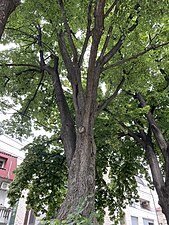Draft:Belgrade Garden: Difference between revisions
Tommyleena (talk | contribs) added a link to Serbia |
Tommyleena (talk | contribs) →Gallery: changed the name |
||
| Line 43: | Line 43: | ||
<gallery> |
<gallery> |
||
</gallery>'''Trees of the Belgrade garden'''<gallery heights="150" mode="packed"> |
</gallery>'''Trees of the Belgrade garden'''<gallery heights="150" mode="packed"> |
||
File:Tilia in Belgrade garden.jpg| |
File:Tilia in Belgrade garden.jpg|Linden ''(Tilia)'' |
||
File:Pine tree in the Belgrade garden.jpg|Pine ''(Pínus'') |
File:Pine tree in the Belgrade garden.jpg|Pine ''(Pínus'') |
||
File:Birch tree in the Belgrade garden.jpg|Birch ''(Bétula'') |
File:Birch tree in the Belgrade garden.jpg|Birch ''(Bétula'') |
||
Revision as of 16:16, 20 March 2024
 | Review waiting, please be patient.
This may take 6 weeks or more, since drafts are reviewed in no specific order. There are 1,011 pending submissions waiting for review.
Where to get help
How to improve a draft
You can also browse Wikipedia:Featured articles and Wikipedia:Good articles to find examples of Wikipedia's best writing on topics similar to your proposed article. Improving your odds of a speedy review To improve your odds of a faster review, tag your draft with relevant WikiProject tags using the button below. This will let reviewers know a new draft has been submitted in their area of interest. For instance, if you wrote about a female astronomer, you would want to add the Biography, Astronomy, and Women scientists tags. Editor resources
Reviewer tools
|
| Belgrade garden | |
|---|---|
 View on the church of St. Anthony of Padua from the Belgrade garden. | |
| Type | Urban garden |
| Location | Belgrade, Serbia |
| Coordinates | 44°47′50″N 20°29′30″E / 44.79722°N 20.49167°E |
| Website | Belgrade garden on Facebook |
Belgrade garden (Serbian Cyrillic: Београд башта, romanized: Beograd bašta), located on Bregalnicka Street in Belgrade, Serbia, is a historically significant green space within the city.
Originally established in the 1930s as a private botanical garden owned by a wealthy family, Belgrade garden has undergone several transformations over the years. After World War II, the garden was repurposed as a theater venue and later converted into an open-air cinema, providing entertainment and cultural experiences to the local community. Today, the theatre scene is used for local concerts and art exhibitions, contributing to the cultural scene of Belgrade. 28 trees of different species in the garden provide shade and cooling during hot summers. Belgrade Garden stands as a testament to the city's rich history and cultural heritage, offering a tranquil retreat and gathering space for residents and visitors alike.
The Church of St. Anthony of Padua can be seen from the Belgrade garden.
History
In the 1930s, the land where Belgrade garden now stands, along with an adjoining plot, was purchased by Greta Minh, a noblewoman from a Jewish family that owned a fabric in Belgrade and a coal mine in Rtanj. She ordered the construction of a villa on one portion of the land, while dedicating the other to the creation of a botanical garden. The villa, located at Silvija Kranjcevica 9, has since been repurposed into a kindergarten.[1] Minh's botanical garden boasted numerous conifers, which was probably one of the reasons why the whole area was called "Borov park" in Serbian, or "Conifer Park" in English. Notably, today the district where Belgrade garden is located is called Lipov lad, and there are several giant linden trees growing in the garden.

Following the upheaval of World War II, Greta Minh, who was of Jewish descent, had to flee from the area.[2] The botanical garden was subsequently nationalized, a scene was built there and the site repurposed into a theatre. By 1955, it had transformed into an open-air cinema, accommodating up to 900 spectators with its bench seating.[3] However, the cinema's decline began in the 1970s due to financial woes, ultimately leading to bankruptcy for the film company. Consequently, the garden fell into disrepair until recent years.[4]
Local residents have since initiated efforts to rejuvenate Belgrade garden. The former cinema seating area has been converted into a basketball court. Summer of 2023, a local café hosted a rock concert within the garden, showcasing its potential as a community event venue.

Belgrade Garden attracts local birdwatchers and plant enthusiasts, solidifying its importance within the community.
Belgrade garden also has several accounts on social media.[5][6]
Flora and fauna
Flora:
Belgrade garden hosts a variety of plant species, with 28 trees of different types growing there. These include various linden, maple, ginkgo, mulberry, common yew, cedar, birch, walnut, pine, Ailanthus, and fir trees. Other plant life such as elderflower, cherry, and bamboo also contribute to the garden's greenery. During spring, certain areas are left to grow wildflowers and grasses, including violet, veronica, dandelions, and Stellaria.
Fauna:
The garden attracts a range of wildlife, with woodpeckers, crows, pigeons, great tits, and blue tits commonly seen. Sparrow houses are positioned along one wall, providing shelter. Firebugs (Pyrrhocoris apterus), are often found near the linden trees. There are several dead stumps in the Belgrade garden, each serving as a unique habitat within the ecosystem. One stump has been repurposed into an insect hotel, providing refuge for various insects. Others host different types of fungi, adding to the biodiversity of the garden and contributing to the natural decomposition process.
Gallery
Trees of the Belgrade garden
-
Linden (Tilia)
-
Pine (Pínus)
-
Birch (Bétula)
-
A firebug Pyrrhocoris apterus among fallen ginkgo leaves
-
A walnut tree (Júglans)
-
Tree-of-heaven (Ailanthus)
References
- ^ Кућа породице Минх, Век касниjе [The Minh family house, a century later] (in Serbian and English). Serbia: Републички завод за заштиту споменика културе. 2022. p. 25. ISBN 978-86-6299-050-1.
- ^ "Greta i Julius Minh priča duga četrdeset godina - Rtanj Adventure" (in Serbian). 2018-11-30. Retrieved 2024-02-28.
- ^ "Facebook". www.facebook.com. Retrieved 2024-02-28.
- ^ "Priča o Minhovima i nama - Vreme" (in Serbian). Retrieved 2024-02-28.
- ^ "Facebook". www.facebook.com. Retrieved 2024-02-28.
- ^ "Instagram". www.instagram.com. Retrieved 2024-02-28.






